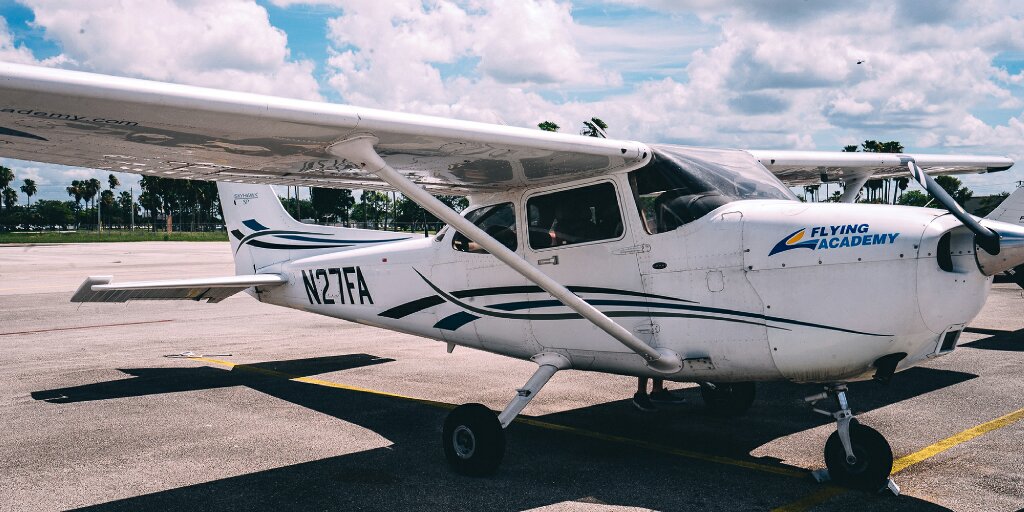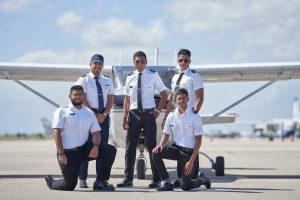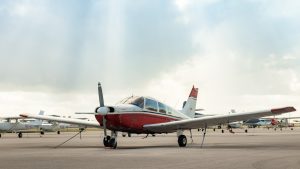
Cessna 172R
The Skyhawk R was introduced in 1996 and is powered by a derated Lycoming IO-360-L2A, producing a maximum of 160 horsepower (120 kW) at just 2,400 rpm. This is the first Cessna 172 to have a factory-fitted fuel-injected engine.
The 172R’s maximum takeoff weight is 2,450 lb (1,111 kg). This model year introduced many improvements, including a new interior with soundproofing, an all-new multi-level ventilation system, a standard four-point intercom, contoured, energy absorbing, 26g front seats with vertical and reclining adjustments, and inertia reel harnesses.
General characteristics
- Crew: one
- Capacity: three passengers
- Length: 27 ft 2 in (8.28 m)
- Wingspan: 36 ft 1 in (11.00 m)
- Height: 8 ft 11 in (2.72 m)
- Wing area: 174 sq ft (16.2 m2)
- Aspect ratio: 7.32
- Airfoil: modified NACA 2412
- Empty weight: 1,691 lb (767 kg)
- Gross weight: 2,450 lb (1,111 kg)
- Fuel capacity: 56 US gallons (212 litres)
- Powerplant: 1 × Lycoming IO-360-L2A four cylinder, horizontally opposed aircraft engine, 160 hp (120 kW)
- Propellers: 2-bladed metal, fixed pitch
Performance
- Cruise speed: 122 kn (140 mph; 226 km/h)
- Stall speed: 47 kn (54 mph; 87 km/h) (power off, flaps down)[88]
- Never exceed speed: 163 kn (188 mph; 302 km/h) (IAS)[12]
- Range: 696 nmi (801 mi; 1,289 km) with 45 minute reserve, 55% power, at 12,000 ft
- Service ceiling: 13,500 ft (4,100 m)
- Rate of climb: 721 ft/min (3.66 m/s)
- Wing loading: 14.1 lb/sq ft (68.6 kg/m2)
Avionics
- Optional Garmin G1000 primary flight display
Cessna 172S
Cessna 172S Skyhawk, built 2001, at Bristol Airport, Bristol, England(2014)
The Cessna 172S was introduced in 1998 and is powered by a Lycoming IO-360-L2A, producing 180 horsepower (134 kW). The maximum engine rpm was increased from 2,400 rpm to 2,700 rpm resulting in a 20 hp (15 kW) increase over the “R” model. As a result, the maximum takeoff weight was increased to 2,550 lb (1,157 kg). This model is marketed under the name Skyhawk SP, although the Type Certification datasheet specifies it is a 172S.
The 172S is built primarily for the private owner-operator and is, in its later years, offered with the Garmin G1000 avionics package and leather seats as standard equipment.
As of 2009, only the S model is in production.
Dimensions
- Length: 27 ft 2 in (8.28 m)
- Height: 8 ft 11 in (2.72 m)
- Wingspan: 36 ft 1 in (11.00 m)
- Wing Area: 174 sq ft (16 sq m)
- Wheelbase: 5 ft 5 in (1.65 m)
Cabin Interior
- Height: 48 in (1.22 m)
- Width: 40 in (1.00 m)
- Length: 11 ft 10 in (3.61 m)
- Maximum Passengers: 4
Baggage Capacity
- Weight: 120 lb (54 kg)
- Volume: 30 cu ft (0.85 cu m)
Weights
- Maximum Ramp Weight: 2,558 lb (1,160 kg)
- Maximum Takeoff Weight: 2,550 lb (1,157 kg)
- Maximum Landing Weight: 2,550 lb (1,157 kg)
- Usable Fuel Capacity
- Weight: 318 lb (144 kg)
- Volume: 53 gal (201 l)
- Basic Operating Weight: 1,641 lb (744 kg)
- Useful Load: 917 lb (416 kg)
- Maximum Payload: 909 lb (412 kg)
- Full Fuel Payload: 599 lb (272 kg)
Performance
- Maximum Cruise Speed: 124 ktas (142 mp/h, 230 km/h)
- Maximum Range: 640 nm (736 m, 1185 km)
Takeoff
- Takeoff Distance: 1,630 ft (497 m)
- Ground Roll: 960 ft (293 m)
Landing
- Landing Distance: 1,335 ft (407 m)
- Ground Roll: 575 ft (175 m)
- Maximum Operating Altitude: 14,000 ft (4,267 m)
- Maximum Climb Rate: 730 fpm (223 mpm)
- Maximum Limit Speed: 163 kias (187 m/h, 302 km/h)
- Stall Speed: 48 kcas (55 m/h, 89 km/h)
Powerplant
- Manufacturer: Textron Lycoming
- Model: (1) IO-360-L2A
- Power Output: 180 hp
Propeller
- Manufacturer: McCauley
- Description: 2-blade metal, fixed pitch
Cessna 172RG Cutlass
Cessna introduced a retractable landing gear version of the 172 in 1980 and named it the Cutlass 172RG.
The Cutlass featured a variable-pitch, constant-speed propeller and a more powerful Lycoming O-360-F1A6 engine of 180 horsepower (130 kW). The 172RG sold for about US$19,000 more than the standard 172 of the same year and produced an optimal cruise speed of 140 knots (260 km/h), compared to 122 knots (226 km/h) for the contemporary 160 horsepower (120 kW) version.
The 172RG did not find wide acceptance in the personal aircraft market because of higher initial and operating costs accompanied by mediocre cruising speed, but was adopted by many flight schools since it met the specific requirements for “complex aircraft” experience necessary to obtain a Commercial Pilot certificate (the role for which it was intended), at relatively low cost. Between 1980 and 1984 1177 RGs were built, with a small number following before production ceased in 1985.
While numbered and marketed as a 172, the 172RG was actually certified on the Cessna 175 type certificate.
The general characteristics and performance specifications for the Cessna 172RG ‘Cutlass II’ are provided below. This is based on data from the Cessna web site, data in the aircraft details provided by Alabeo, and general research sources. Some of this data varies between sources and also may be an approximation due to variances in data and the specific aircraft modeled by Alabeo.
General characteristics
- Crew: one
- Capacity: three passengers
- Length: 27 ft 2 in (8.28 m)
- Wingspan: 36 ft 1 in (11.0 m)
- Height: 8 ft 11 in (2.72 m)
- Wing area: 174 ft2 (16.17 m2)
- Empty weight: 1.590 lb (721 kg)
- Fuel capacity: 66 US gal (249.8 l)
- Maximum take-off weight (MTOW): 2.650 lb (1.202 kg)
- Power plant: Lycoming O-360-F1A6 air-cooled, horizontally opposed, four-cylinder, 180 hp (134 kW)
Performance
- Maximum speed: 145 kts (167 mph, 269 km/h)
- Cruise speed: 140 kts (161 mph, 259 km/h), 75% power at 9.000 ft (2.743 m)
- Stall speed: 50 kts (58 mph, 93 km/h) full flaps, engine at idle
- Range: 720 nm (829 mi, 1.333 km) 75% power at 9.000 ft (2,743 m)
- Service ceiling: 16.800 ft (5.121 m)
- Rate of climb: 800 ft/min (244 m/min) maximum
Cessna 172M
Cessna 172M of 1973–76 gained a drooped wing leading edge for improved low-speed handling. This was marketed as the “camber-lift” wing.
The 1974 172M was also the first to introduce the optional ‘II’ package which offered higher standard equipment, including a second nav/comm radio, an ADF and transponder. The baggage compartment was increased in size, and nose-mounted dual landing lights were available as an option.
The 1975 model 172M sold for US$16,055 for the 172, US$17,890 for the Skyhawk and US$20,335 for the Skyhawk II.
In 1976, Cessna stopped marketing the aircraft as the 172 and began exclusively using the “Skyhawk” designation. This model year also saw a redesigned instrument panel to hold more avionics. Among other changes, the fuel and other small gauges are relocated to the left side for improved pilot readability compared with the earlier 172 panel designs. Total production of “M” models was 7306 over the four years it was manufactured.
General characteristics
- Engine type: Piston – normally aspirated
- Engine make: Lycoming O-320-E2D
- Engine power: 150
- Engine TBO: 2000
- Production: 1976
Performance
- Horsepower: 150 Gross Weight: 2300 lbs
- Top Speed: 122 kts Empty Weight: 1335 lbs
- Cruise Speed: 115 kts Fuel Capacity: 42 gal
- Stall Speed (dirty): 44 kts Range: 435 nm 806 km
Speeds
- Max cruising speed: 122 KTS
- Recommended cruise: 115 KTS
- Stall speed: 44 KTS
- Fuel capacity standard fuel: 159 Litres
- Long range fuel: 197 Litres
Range
- Range at std. cruise: 435 NM
- Ceilings service ceiling: 13 100 Feet
Climb performance
- Maximum rate of climb at sea level: 645 Feet per Minute
Weights Pounds Kilograms
- Maximum takeoff weight: 2300 1043
- Standard empty weight: 1335 606
- Maximum useful load: 965 438
- Maximum useful load with full fuel: 713 323
Takeoff & landing distance at sea level Feet Metres
- Takeoff ground roll, gross weight: 865 264
- Takeoff over 50’ obstacle, gross weight: 1525 465
- Landing ground roll, gross weight: 520 159
- Landing over 50’ obstacle, gross weight: 1250 381
Aircraft dimensions Feet Meters
- Overall length: 26.92 8.21
- Tail height: 8.83 2.69
- Wingspan: 35.83 10.92
Takeoff Landing
- Ground Roll: 865 ft Ground Roll 520 ft
- Over 50 ft obstacle: 1525 ft Over 50 ft obstacle: 1250 ft
- Rate Of Climb: 645 fpm
- Ceiling: 13100 ft
Cessna 172N
The Skyhawk N, or Skyhawk/100 as Cessna termed it, was introduced for the 1977 model year. The “100” designation indicated that it was powered by a Lycoming O-320-H2AD, 160 horsepower (119 kW) engine designed to run on 100-octane fuel, whereas all previous engines used 80/87 fuel. But this engine proved troublesome, and it was replaced by the similarly rated O-320-D2J to create the 1981 172P.
The 1977 “N” model 172 also introduced rudder trim as an option and standard “pre-selectable” flaps. The price was US$22,300, with the Skyhawk/100 II selling for US$29,950.
The 1978 model brought a 28-volt electrical system to replace the previous 14-volt system. Air conditioning was optional.
The 1979 model “N” increased the flap-extension speed for the first 10 degrees to 115 knots (213 km/h). Larger wing tanks increased the optional fuel to 66 US gallons (250 l).
The “N” remained in production until 1980 when the 172P or Skyhawk P was introduced.
General characteristics
Gross weight: 2300 lbs
Fuel capacity: 43 gal
Empty weight: 1430 lbs
Performance
Cruise speed: 122 kts
Stall speed: 44 kts
Range: 440 nm 815 km
Horsepower: 160
Top speed: 124 kts
Ceiling: 14200 ft
Takeoff
Ground roll: 820 ft
Over 50 ft obstacle: 1390 ft
Landing
Ground roll: 520 ft
Over 50 ft obstacle: 1250 ft
Climb performance
Rate of climb: 770 fpm






